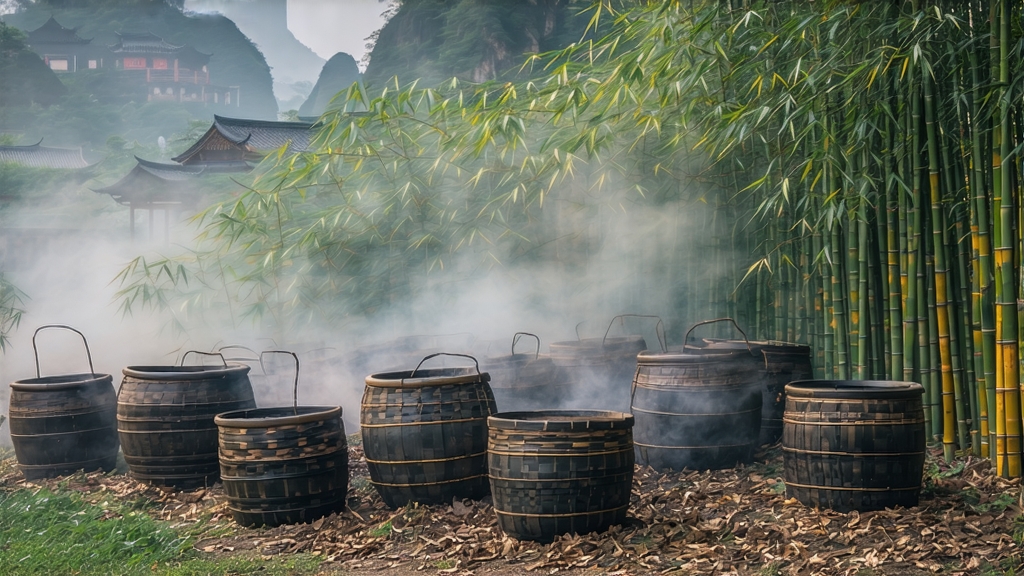
Tucked high in the mist-veiled Dabie Mountains of western Anhui Province, a tea so rare that even lifelong Chinese connoisseurs may never taste it in its authentic form continues to be crafted exactly as it was in the Ming Dynasty. Huoshan Huangya—literally “Yellow Bud of Huoshan”—is the eastern member of China’s tiny yellow-tea family, a category defined not by leaf color but by a secretive, labor-intensive “sweating” process that turns green into gold. Less famous than Longjing or Da Hong Pao, this yellow tea carries the quiet dignity of an imperial tribute, once freighted down the Shanxi merchant roads to the Forbidden City in red-sealed crates. Today it offers the global tea traveler a liquid time-capsule: the aroma of mountain orchids suspended in a liquor the color of morning sunlight on old parchment.
History: From Imperial Tribute to Mountain Secret
The first written record appears in 1602, when the Huoshan County Gazetteer notes that “yellow buds are presented to the capital, sealed on the day of Grain Rain.” During the Kangxi reign (1662-1722) the tea was levied as tax, and palace archives list it among “eight precious teas” reserved for emperors’ spring ancestral rites. When the Qing collapsed, the craft almost vanished; Republican-era warlords requisitioned the gardens for opium, and the 1949 revolution collectivized the slopes into state farms. A 1972 state visit by Japanese Premier Tanaka briefly revived production for diplomatic gifts, yet true menhuang (“slow yellowing”) technique survived only in three family workshops inside the Jinjiaping micro-valley. In 2008 the Chinese Ministry of Culture listed Huoshan Huangya as a National Intangible Heritage, and since 2015 a small cooperative of thirty growers has resumed tribute-grade batches, totaling barely two metric tons per year.
Terroir: Why the Dabie Mountains Taste Like Orchid Milk
Huoshan County straddles 31° N at 600–800 m elevation, where the Dabie range funnels humid air from the Yangtze floodplain into nightly fog. The soil is Phyllitic quartz sandstone, slightly acidic (pH 5.2) and laced with selenium leached from ancient granite intrusions. Day-night temperature differentials of 12 °C slow amino-acid metabolism, concentrating L-theanine; the result is a brothy sweetness that locals describe as “orchid milk.” Only three clones are permitted for authentic Huangya: Huoshan early-bud #1, Dabie small-leaf #3, and the heirloom “duck-foot” strain whose leaves resemble webbed feet. Gardens are interplanted with sweet-scented osmanthus and bamboo to regulate humidity and fix floral volatiles in the leaf surface.
Plucking: One Bud, One Leaf, Before the Thrush Sings
The picking window opens on the 5th solar term (Qingming) and closes exactly twenty days later, when the local thrush begins its dawn chorus—an acoustic cue still used by farmers without smartphones. Standard is “one bud recently unfolded with one fish-leaf,” 2.0–2.5 cm in length. Pickers wear bamboo hats but no gloves, believing that fingertip temperature must awaken the bud. Leaves are laid in shallow mountain willow baskets lined with fresh fern fronds to prevent compression bruising; the trek to the village workshop must be completed within 90 minutes so the enzymatic clock set by mountain dew is not lost.
Craft: The Lost Art of Menhuang—“Slow Yellowing”
Yellow tea’s identity lies neither in cultivar nor terroir but in this unique post-fixation fermentation. The process is divided into five acts, each governed by humidity, temperature, and intuition rather than timers.
-
Kill-Green over Peach-Wood Charcoal
Leaves are hand-tossed in a 160 °C iron wok for 90 seconds, just enough to deactivate polyphenol oxidase while preserving a 7 % moisture rim around the midrib. Peach wood is chosen because its smoke carries a faint benzaldehyde note that later marries with the tea’s own coumarin. -
Initial Roll & Cloth Wrapping
While still at 50 °C, the leaves are rolled on a bamboo tray until 40 % cell rupture is achieved, then wrapped in steamed hemp cloth to trap heat. Over 45 minutes the bundle “